dashboard RENAULT KANGOO 1997 KC / 1.G Electrical Equipment User Guide
[x] Cancel search | Manufacturer: RENAULT, Model Year: 1997, Model line: KANGOO, Model: RENAULT KANGOO 1997 KC / 1.GPages: 83
Page 33 of 83
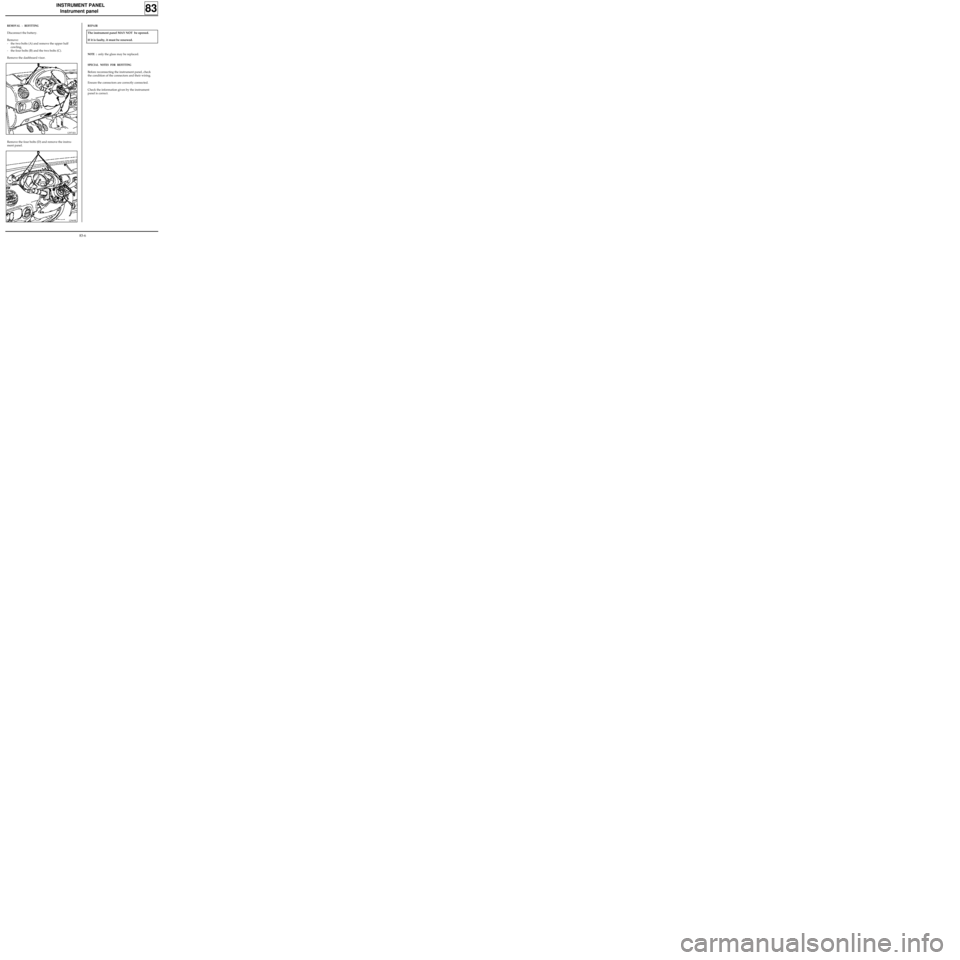
INSTRUMENT PANEL
Instrument panel
83
REMOVAL - REFITTING
Disconnect the battery.
Remove:
- the two bolts (A) and remove the upper half
cowling,
- the four bolts (B) and the two bolts (C).
Remove the dashboard visor.
12971R1
REPAIR
The instrument panel MAY NOT be opened.
If it is faulty, it must be renewed.
Remove the four bolts (D) and remove the instru-
ment panel.
12969R
NOTE : only the glass may be replaced.
SPECIAL NOTES FOR REFITTING
Before reconnecting the instrument panel, check
the condition of the connectors and their wiring.
Ensure the connectors are correctly connected.
Check the information given by the instrument
panel is correct.
83-6
Page 43 of 83
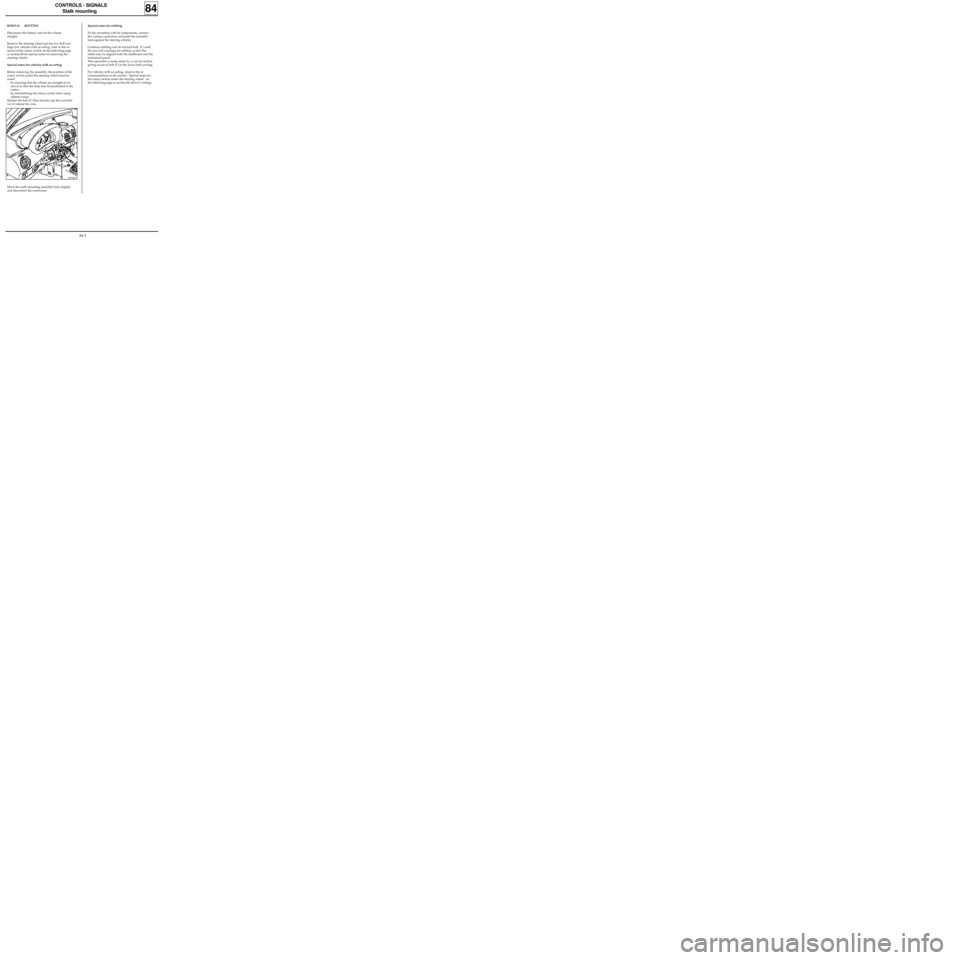
CONTROLS - SIGNALS
Stalk mounting
REMOVAL - REFITTING
Disconnect the battery and set the wheels
straight.
Remove the steering wheel and the two half cow-
lings (for vehicles with an airbag, refer to the re-
moval of the rotary switch on the following page
or section 88 for special notes on removing the
steering wheel).
Special notes for vehicles with an airbag
Before removing the assembly, the position of the
rotary switch under the steering wheel must be
noted:
- by ensuring that the wheels are straight on re-
moval so that the strip may be positioned in the
centre,
- by immobilising the rotary switch rotor using
adhesive tape.
Slacken the bolt (C) then sharply tap the screwdri-
ver to release the cone.
84
Special notes for refitting
Fit the mounting with its components, connect
the various connectors and push the assembly
back against the steering column.
Continue refitting and do not lock bolt (C) until
the two half cowlings are refitted, so that the
stalks may be aligned with the dashboard and the
instrument panel.
This operation is made easier by a cut-out section
giving access to bolt (C) in the lower half cowling.
For vehicles with an airbag, observe the re-
commendations in the section " Special notes for
the rotary switch under the steering wheel" on
the following page or section 88 (driver’s airbag).
12970R2
Move the stalk mounting assembly back slightly
and disconnect the connectors.
84-3
Page 51 of 83

ELECTRICAL ASSISTANCE EQUIPMENT
Relay plate
POSITION AND ALLOCATION
(Most complete plate)
87
12965R
The relays are located above the fuse board at the
bottom of the dashboard. To reach them, open
the fuse box cover.
1 Lights on reminder buzzer
2 Front wiper timer
3 Flasher unit
4 Rear wiper timer
5 Heated rear screen relay
6 After ignition relay (electric window feed)
7 Front fog lights relay
87-1
Page 60 of 83

WIRING
Remote control for door locking
88
Ignition off:
1.Press and hold the central door locking button
for a few seconds until the doors lock and un-
lock.
From this moment, the operator has 10 se-
conds to carry out the next operation.
NOTE: The 10 seconds are shown by the illu-
mination of the red immobiliser warning light
(if fitted) and bargraph 17 LH on the XR25
(code
D56, fiche n° 56).
2.Press the remote control twice (the doors lock
and unlock and the red warning light extin-
guishes, if fitted).
NOTE : If both remote controls (if fitted) are
desynchronised, two resynchronisation proce-
dures will have to be carried out (one for each
remote control).
IMPORTANT: To ensure that the infrared code
is correctly transmitted it is essential to direct
the transmitter correctly towards the receiver.
If the procedure fails it will be necessary to
restart from the beginning (infrared remote
control only).
3.The procedure is complete - check that the
doors lock correctly.
Removal - Refitting
The dashboard must be partially removed to re-
move the decoder unit.
Remove:
- the steering wheel with the wheels straight,
- the half cowlings under the steering wheel,
- the knee protector under the steering column,
- the lights and wiper controls,
- the instrument panel surround,
- the instrument panel,
- the ashtray, its mounting and the two dash-
board mounting bolts on the heating unit,
- the trim at the bottom of the dashboard on the
driver’s side,
- the two speaker grilles on the dashboard,
- the dashboard mountings.
THE DECODER UNIT
The decoder unit is located in the left hand side of
the dashboard (A).
12967R
88-5
Page 61 of 83
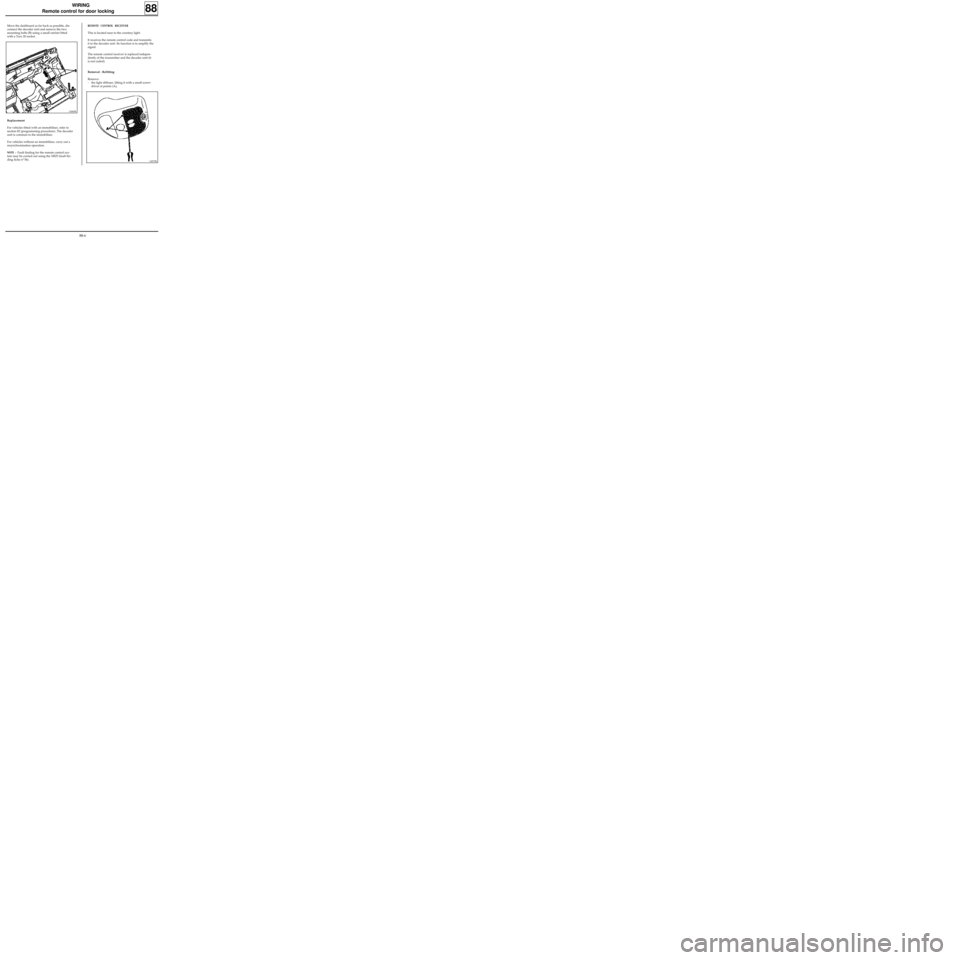
WIRING
Remote control for door locking
88
REMOTE CONTROL RECEIVER
This is located near to the courtesy light.
It receives the remote control code and transmits
it to the decoder unit. Its function is to amplify the
signal.
The remote control receiver is replaced indepen-
dently of the transmitter and the decoder unit (it
is not coded).
Removal - Refitting
Remove:
- the light diffuser, lifting it with a small screw-
driver at points (A),
13073R
13065R
Replacement
For vehicles fitted with an immobiliser, refer to
section 82 (programming procedure). The decoder
unit is common to the immobiliser.
For vehicles without an immobiliser, carry out a
resynchronisation operation.
NOTE : Fault finding for the remote control sys-
tem may be carried out using the XR25 (fault fin-
ding fiche n° 56).
Move the dashboard as far back as possible, dis-
connect the decoder unit and remove the two
mounting bolts (B) using a small ratchet fitted
with a Torx 20 socket.
88-6
Page 63 of 83
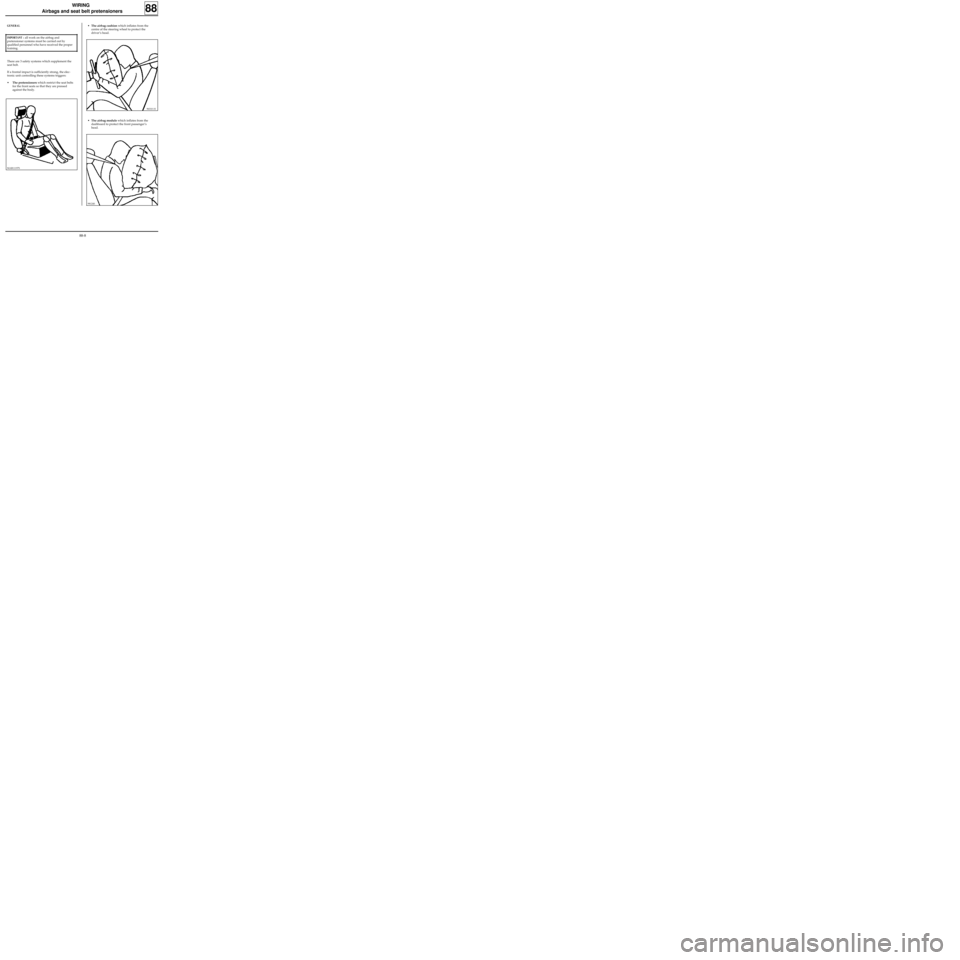
96310-1S
MAB11197S
WIRING
Airbags and seat belt pretensioners
GENERAL
88
IMPORTANT : all work on the airbag and
pretensioner systems must be carried out by
qualified personnel who have received the proper
training.
There are 3 safety systems which supplement the
seat belt.
If a frontal impact is sufficiently strong, the elec-
tronic unit controlling these systems triggers:
•The pretensioners which restrict the seat belts
for the front seats so that they are pressed
against the body.
•The airbag cushion which inflates from the
centre of the steering wheel to protect the
driver’s head.
•The airbag module which inflates from the
dashboard to protect the front passenger’s
head.
98124S
88-8
Page 64 of 83

DI8816 DI8817
WIRING
Airbags and seat belt pretensioners
88
FUNCTION AND OPERATION OF THE AIRBAGS AND PRETENSIONERS
1) Function
In the event of an accident, the airbag prevents the head striking the steering wheel or dashboard.
It also reduces the maximum acceleration of the head, by absorption.
2) Trigger threshold
Generally speaking, there are four different basic situations.
1) FRONTAL IMPACT AGAINST A OBSTACLE
The trigger speed depends on the obstacle’s
surface. The softer the surface, the higher the
speed.
The pretensioner generally triggers at a lower
speed than the airbag.
2) OFFSET IMPACT AGAINST A OBSTACLE
In this case, the airbag trigger speed depends on
the angle of impact α.
The greater the angle, the higher the vehicle
speed for triggering.
ADirection of travel
BCentre of gravity
88-9
Page 66 of 83

WIRING
Airbags and seat belt pretensioners
88
92656S
The new 30-track computers are provided with
the K and L lines for fault finding with the XR25
(except for vehicles with pretensioners only).
This enables computer faults or faulty lines to be
detected in the system (see section on fault fin-
ding).
NOTE: before each operation an auxiliary func-
tion enables the ignition lines to be de-activated
to prevent the risk of triggering the pyrotechnic
gas generators.
Various vehicle configurations are possible:
Vehicle fitted with:
- pretensioners only,
- pretensioners and driver’s airbag,
- pretensioners and driver’s airbag and passen-
ger’s airbag.
NOTE :
• A vehicle fitted with a driver’s airbag will be
identified by a label in the bottom corner of
the windscreen on the driver’s side, and by the
word "Airbag" in the centre of the steering
wheel.
• If a passenger airbag is fitted, a second label is
located in the lower corner of the windscreen
on the passenger side and the word "Airbag" is
located on the dashboard on the same side.
Each time the windscreen is replaced, remember
to fit the labels showing that the vehicle is fitted
with airbags.
These labels are available in a kit Part Number :
77 01 205 442.
SPECIAL TOOLING
PRESENTATION
XR25
88-11
Page 72 of 83

WIRING
Airbags and seat belt pretensioners
88
WARNING LIGHT ON THE DASHBOARD
This warning light controls the pretensioners and
airbags, except for vehicles fitted with pretensio-
ners only.
It should illuminate for a few seconds when the
ignition is switched on, then extinguish (and
remain extinguished). If it does not illuminate
when the ignition is switched on, or illuminates
when the vehicle is being driven, there is a fault in
the system (see fault finding section).
IMPORTANT : the systems MUST be checked by
means of the
XRBAG, following:
- an accident which has not given rise to
triggering,
- theft or attempted theft of the vehicle,
- before the sale of a used vehicle.
These systems are not triggered in the case of:
- a lateral impact,
- a rear impact.
When it is triggered the pyrotechnic gas
generator produces an explosion combined with
light smoke.
NOTE : With pretensioners only,the computer has
a single sensor (electromechanical).
OPERATIONS ON THE TRIGGER LINES
If a fault is noted on one of these lines, the
component must be renewed and not repaired.
This safety equipment cannot be subjected to any
conventional wiring or connector repair opera-
tions.
The airbag trigger wiring is integrated into the
passenger compartment wiring loom . To make
replacement easier, cut the two ends of the faulty
wiring and run the new wiring along the same
routing, alongside the passenger compartment
wiring loom.
IMPORTANT : When fitting the new wiring, en-
sure it is not in danger of being cut or rubbed and
that the original wiring cleanliness is respected.
NOTE : The trigger lines are supplied by the Parts
Department in a kit containing both airbag and
pretensioner wiring.
OPERATION WITH AIRBAG(S) AND PRETENSIONER
EQUIPMENT
When the ignition is switched on, the
warning light illuminates for a few
seconds then extinguishes.
This computer is then on standby and notes dece-
lerations of the vehicle using the signal measured
by the integral decelerometer.
When a frontal impact of sufficient strength oc-
curs it triggers the simultaneous ignition of the
pyrotechnic generators of the two seat belt pre-
tensioners after receiving confirmation of detec-
tion of an impact by the electromechanical safety
sensor.
Under the action of the gases generated by the
system, a piston is displaced in its cylinder,
carrying with it a cable connected to the
corresponding central catch, thus enabling the
seat belt to be retracted (see pretensioner
section).
If the frontal impact is greater than this, the dece-
lerometer triggers the ignition of the pyrotechnic
gas generators which inflate the driver and pas-
senger airbags once the impact has been valida-
ted by the electromechanical safety sensor.
88-17
Page 79 of 83
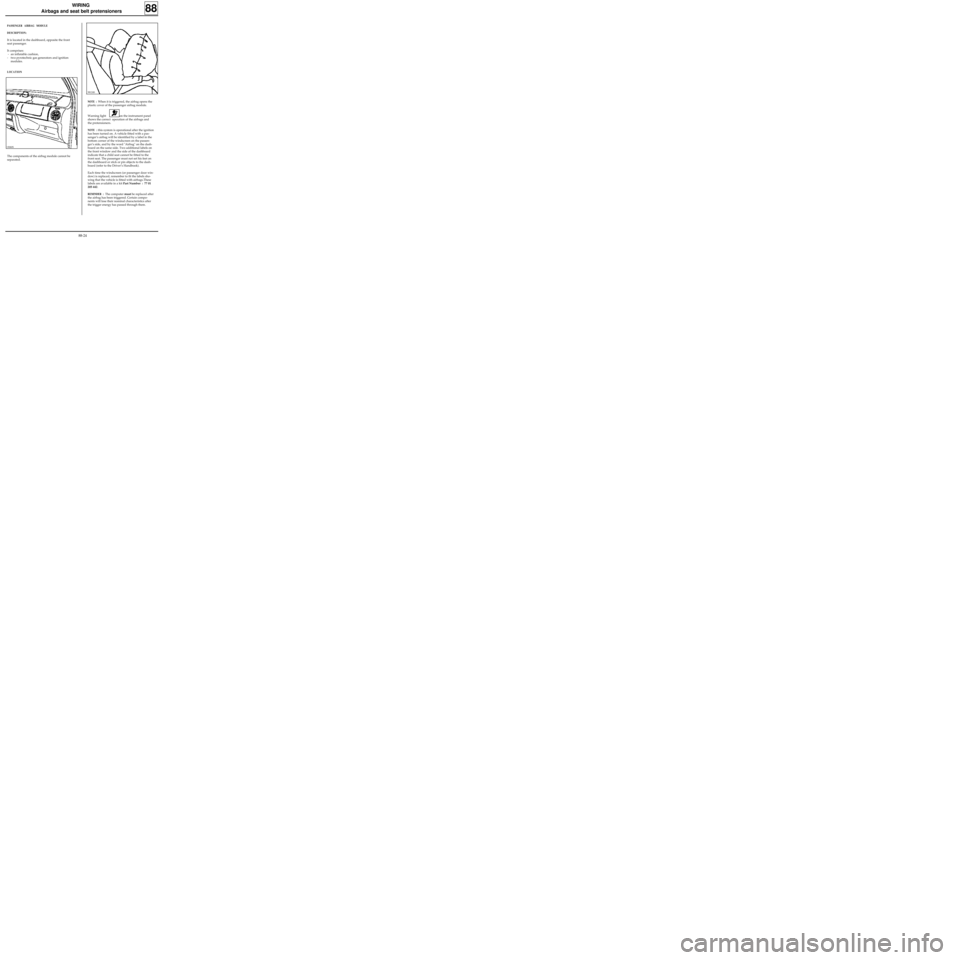
WIRING
Airbags and seat belt pretensioners
88
PASSENGER AIRBAG MODULE
DESCRIPTION:
It is located in the dashboard, opposite the front
seat passenger.
It comprises:
- an inflatable cushion,
- two pyrotechnic gas generators and ignition
modules.
LOCATION
The components of the airbag module cannot be
separated.
98124S
NOTE : When it is triggered, the airbag opens the
plastic cover of the passenger airbag module.
Warning light on the instrument panel
shows the correct operation of the airbags and
the pretensioners.
NOTE : this system is operational after the ignition
has been turned on. A vehicle fitted with a pas-
senger’s airbag will be identified by a label in the
bottom corner of the windscreen on the passen-
ger’s side, and by the word "Airbag" on the dash-
board on the same side. Two additional labels on
the front window and the side of the dashboard
indicate that a child seat cannot be fitted to the
front seat. The passenger must not set his feet on
the dashboard or stick or pin objects to the dash-
board (refer to the Driver’s Handbook).
Each time the windscreen (or passenger door win-
dow) is replaced, remember to fit the labels sho-
wing that the vehicle is fitted with airbags.These
labels are available in a kit Part Number : 77 01
205 442.
REMINDER : The computer must be replaced after
the airbag has been triggered. Certain compo-
nents will lose their nominal characteristics after
the trigger energy has passed through them.
13060S
88-24